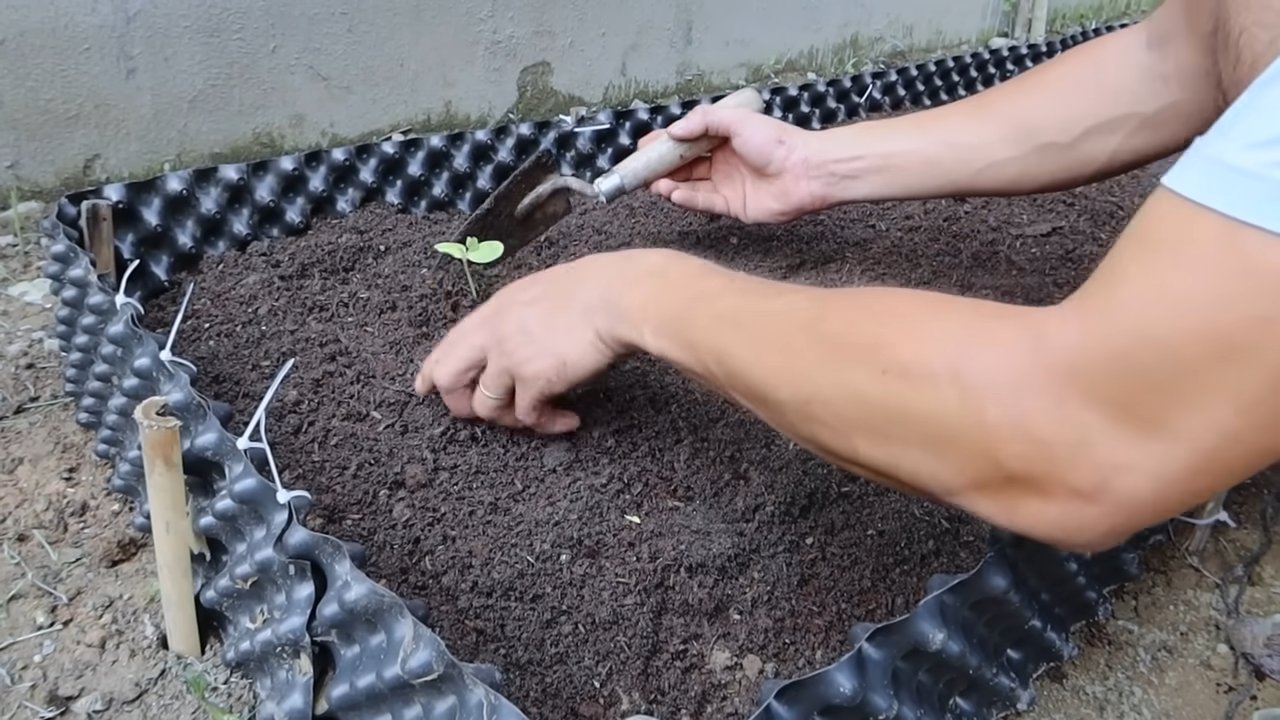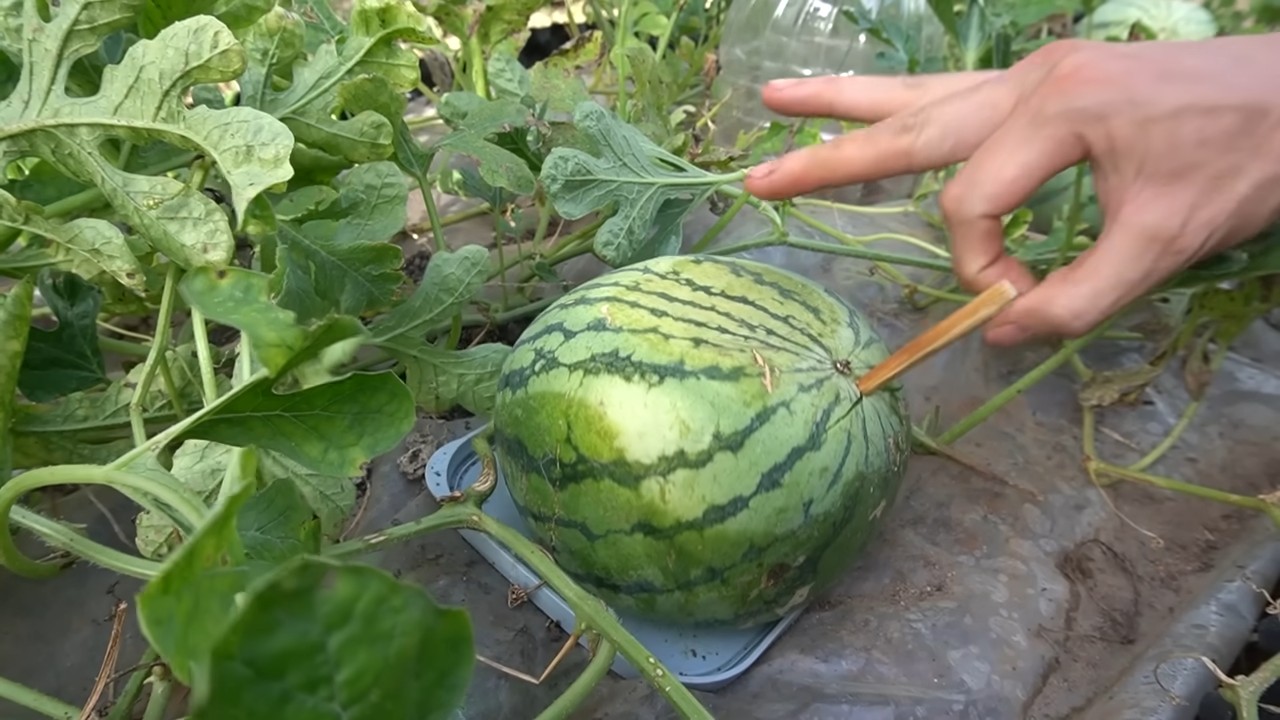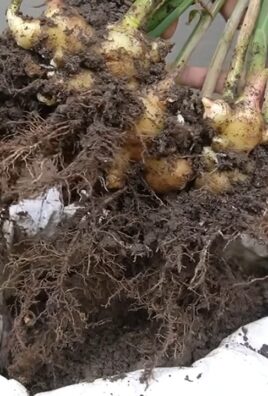Grow Square Watermelons: Sounds like something out of a sci-fi movie, right? But trust me, it’s totally achievable, and I’m here to show you how! For centuries, gardeners have been pushing the boundaries of what’s possible, experimenting with techniques to cultivate unique and eye-catching produce. While the exact origins of square watermelons are debated, they gained popularity in Japan as a space-saving solution for smaller refrigerators and easier stacking for transport.
Let’s be honest, who wouldn’t want to impress their friends and family with a perfectly cubed watermelon? Beyond the novelty factor, growing square watermelons is a fun and engaging project that teaches you about plant development and the power of controlled environments. Plus, they’re incredibly Instagrammable! In this DIY guide, I’ll walk you through the simple steps to grow square watermelons in your own backyard. You’ll learn about the materials you’ll need, the best timing for the process, and some helpful tips to ensure a successful harvest. Get ready to transform your garden into a conversation starter and enjoy the sweet taste of success 鈥?literally!

How to Grow Square Watermelons: A Fun DIY Project!
Hey there, fellow gardening enthusiasts! Ever seen those perfectly square watermelons and wondered how they’re grown? Well, it’s not magic, just a little bit of DIY ingenuity! I’m going to walk you through the process of growing your own square watermelons. It’s a fun project that’s sure to impress your friends and family, and it’s easier than you might think.
What You’ll Need
Before we dive in, let’s gather our supplies. This is crucial for a smooth and successful square watermelon adventure!
* **Watermelon Seeds or Seedlings:** Choose a variety known for its smaller size and relatively thin rind. Sugar Baby or similar varieties work well. I personally prefer starting with seedlings to get a head start, but seeds work just fine too!
* **Square Containers:** This is the heart of the project! You’ll need transparent, sturdy containers. I recommend using acrylic or polycarbonate boxes. Avoid glass, as it can be dangerous if it breaks.
* **Size Matters:** The size of the container will determine the size of your square watermelon. A 8x8x8 inch box will yield a smaller, more manageable watermelon. A 10x10x10 inch box will give you a larger one.
* Drainage is Key: Make sure your containers have drainage holes! Waterlogged watermelons are not happy watermelons.
* Transparency is Important: The transparent sides allow sunlight to reach the entire watermelon, ensuring even ripening.
* **Potting Soil:** Use a well-draining potting mix rich in organic matter. Watermelons are heavy feeders, so a good quality soil is essential.
* **Fertilizer:** A balanced fertilizer (e.g., 10-10-10) or a fertilizer specifically formulated for melons will help your watermelons thrive.
* **Trowel or Shovel:** For planting and transplanting.
* **Watering Can or Hose:** For, well, watering!
* **Gloves:** To keep your hands clean.
* Optional: Trellis or support system if you’re growing your watermelons vertically.
Choosing the Right Watermelon Variety
Not all watermelons are created equal when it comes to square growing. You want a variety that’s relatively small and has a thinner rind. This makes it easier for the watermelon to conform to the shape of the container. Here are a few varieties I’ve had success with:
* **Sugar Baby:** A classic choice, known for its small size and sweet flavor.
* **Golden Midget:** Another small variety with a yellow rind.
* **Bush Sugar Baby:** A compact variety that’s perfect for smaller gardens.
Planting and Initial Growth
This is where the magic begins! We’re going to get our watermelon plants started and give them a good foundation for their square journey.
1. **Start Seeds Indoors (Optional):** If you’re starting from seeds, sow them indoors about 4-6 weeks before the last expected frost. Plant the seeds about 1 inch deep in small pots filled with potting mix. Keep the soil moist and warm (around 70-80掳F).
2. **Prepare the Garden Bed:** Choose a sunny spot in your garden that gets at least 6-8 hours of direct sunlight per day. Watermelons need plenty of sunshine to thrive. Amend the soil with compost or other organic matter to improve drainage and fertility.
3. **Transplant Seedlings (or Direct Sow):** Once the seedlings have developed a few true leaves and the danger of frost has passed, transplant them into the garden. Space the plants about 2-3 feet apart. If you’re direct sowing, plant the seeds about 1 inch deep and thin the seedlings to 2-3 feet apart once they emerge.
4. **Water Regularly:** Watermelons need consistent moisture, especially during hot weather. Water deeply and regularly, but avoid overwatering, which can lead to root rot.
5. **Fertilize:** Apply a balanced fertilizer according to the package directions. You can also side-dress the plants with compost or aged manure.
Introducing the Square Container
This is the crucial step where we guide our watermelon into its square destiny! Timing is everything here.
1. **Timing is Key:** Wait until the watermelon fruit is about the size of a small grapefruit (around 4-6 inches in diameter) before placing it inside the square container. This is important because if you put it in too early, the watermelon might not develop properly. If you wait too long, it might be too big to fit!
2. **Prepare the Container:** Make sure your square container is clean and has adequate drainage holes. Line the bottom of the container with a layer of straw or small pebbles to improve drainage.
3. **Gently Place the Watermelon:** Carefully lift the watermelon and gently place it inside the container. Be very careful not to damage the vine or the fruit.
4. **Secure the Container (Optional):** If you’re worried about the container tipping over, you can secure it to a stake or trellis. I usually just make sure it’s sitting on a stable surface.
5. **Monitor and Adjust:** Keep an eye on the watermelon as it grows. If it seems to be getting too crowded inside the container, you can carefully adjust its position.
Caring for Your Square Watermelon
Now that your watermelon is in its square home, it’s time to provide the care it needs to thrive.
1. **Watering:** Continue to water regularly, making sure the soil stays moist but not waterlogged.
2. **Fertilizing:** Continue to fertilize as needed, following the package directions.
3. **Sunlight:** Ensure the container receives plenty of sunlight. If necessary, rotate the container periodically to ensure even ripening.
4. **Pest and Disease Control:** Keep an eye out for pests and diseases, such as aphids, squash bugs, and powdery mildew. Treat any problems promptly with appropriate organic or chemical controls.
5. **Support the Vine:** As the watermelon grows, the vine may become heavy. Provide support with a trellis or stakes to prevent the vine from breaking.
6. Patience is a Virtue: It takes time for the watermelon to fill out the container and ripen. Be patient and continue to provide the necessary care.
Harvesting Your Square Watermelon
The moment we’ve all been waiting for! Harvesting your square watermelon is the culmination of all your hard work.
1. **Check for Ripeness:** Watermelons are typically ready to harvest when the tendril closest to the fruit turns brown and dry. The bottom of the watermelon (where it rests on the ground) should also turn from white to yellow. You can also thump the watermelon; a ripe watermelon will sound hollow.
2. **Carefully Remove the Watermelon:** Gently lift the watermelon out of the container. Be careful not to drop it!
3. **Cut the Vine:** Use a sharp knife to cut the vine a few inches above the watermelon.
4. **Admire Your Creation:** Take a moment to admire your perfectly square watermelon! You did it!
5. **Enjoy!** Slice it up and enjoy the fruits (or rather, the watermelon) of your labor!
Troubleshooting Tips
Even with the best planning, things can sometimes go awry. Here are a few common problems and how to address them:
* **Watermelon Rotting:** This is usually caused by overwatering or poor drainage. Make sure your container has adequate drainage holes and avoid overwatering. You can also try elevating the container slightly to improve airflow.
* **Watermelon Not Filling Out the Container:** This could be due to a number of factors, such as insufficient sunlight, poor soil, or inadequate watering. Make sure the container is getting plenty of sunlight, the soil is rich in nutrients, and you’re watering regularly.
* **Pests and Diseases:** Keep an eye out for pests and diseases and treat them promptly. Organic options like neem oil or insecticidal soap can be effective for many common problems.
* **Container Too Small:** If the watermelon outgrows the container, you may need to carefully transfer it to a larger container. This can be tricky, so be very gentle.
Tips for Success
Here are a few extra tips to help you grow the best square watermelons possible:
* Start with Healthy Plants: Choose healthy, vigorous seedlings or seeds from a reputable source.
* Provide Plenty of Sunlight: Watermelons need at least 6-8 hours of direct sunlight per day.
* Use Well-Draining Soil: Watermelons don’t like to sit in soggy soil.
* Water Regularly: Water deeply and regularly, especially during hot weather.
* Fertilize Regularly: Watermelons are heavy feeders and need plenty of nutrients.
* Monitor for Pests and Diseases: Catch problems early and treat them promptly.
* Be Patient: Growing square watermelons takes time and effort. Don’t get discouraged

Conclusion
So, there you have it! Growing square watermelons isn’t just a quirky gardening project; it’s a rewarding experience that combines ingenuity, patience, and a touch of agricultural artistry. We’ve walked you through the process, from selecting the right watermelon variety to carefully placing and monitoring your chosen fruit within its custom-built mold. The result? A conversation-starting, space-saving, and undeniably cool addition to your garden and kitchen.
But why is this DIY trick a must-try? Beyond the novelty factor, growing square watermelons offers several practical advantages. Their unique shape makes them incredibly easy to store in the refrigerator, maximizing space and preventing those awkward rolling incidents. They’re also easier to slice and serve, making them a hit at parties and gatherings. Plus, the controlled environment within the mold can sometimes lead to a more uniformly ripe and flavorful watermelon.
Don’t be afraid to experiment with variations! While we’ve focused on the classic square shape, you can explore different mold designs. Consider using heart-shaped or even star-shaped molds for a truly unique presentation. You can also try this technique with other fruits and vegetables, such as cucumbers or pumpkins, to create a whole range of geometrically intriguing produce. Remember to adjust the mold size and timing accordingly to suit the specific fruit or vegetable you’re working with.
The key to success lies in careful observation and consistent monitoring. Regularly check the watermelon’s growth within the mold, ensuring it’s not becoming overcrowded or developing any signs of stress. Adjust the mold as needed to accommodate the growing fruit, and be patient 鈥?it takes time and attention to achieve the perfect square watermelon.
We understand that this project might seem a little daunting at first, but trust us, the satisfaction of harvesting your own perfectly shaped watermelon is well worth the effort. It’s a fantastic way to connect with nature, learn about the growing process, and impress your friends and family with your gardening skills.
So, what are you waiting for? Grab your seeds, build your molds, and get ready to embark on this exciting gardening adventure. We’re confident that you’ll be amazed by the results. And most importantly, don’t forget to share your experience with us! We’d love to see your square watermelon creations and hear about any tips or tricks you discover along the way. Post photos and stories of your **grow square watermelons** journey on social media using [Your Hashtag Here], and let’s inspire others to try this fun and rewarding DIY project. Happy gardening!
Frequently Asked Questions (FAQ)
What type of watermelon is best for growing in a square mold?
The best watermelons for growing in square molds are smaller, oblong varieties that fit comfortably within the mold without being overly cramped. Sugar Baby, Golden Midget, and other compact watermelon types are excellent choices. Avoid large, round varieties like Charleston Gray, as they may not adapt well to the confined space of the mold. Consider the mature size of the watermelon variety and choose a mold that provides adequate room for growth without being excessively large.
When is the ideal time to place the watermelon in the mold?
The optimal time to introduce the watermelon to the mold is when it’s approximately the size of a tennis ball or slightly larger. At this stage, the watermelon is still actively growing and pliable enough to conform to the shape of the mold. Placing the watermelon in the mold too early, when it’s very small, may result in it not filling the mold completely. Waiting too long, until the watermelon is too large, can cause it to become stressed or even crack as it tries to expand within the confined space. Regular monitoring of your watermelons is crucial to determine the perfect timing.
What type of material should I use for the mold?
The mold should be constructed from a durable, food-safe material that can withstand the weight of the growing watermelon and the elements. Clear acrylic or polycarbonate plastic are popular choices, as they allow you to observe the watermelon’s growth without removing the mold. Wood can also be used, but it’s essential to ensure it’s treated with a non-toxic sealant to prevent rot and contamination. The mold should have drainage holes to prevent water from accumulating inside and potentially causing the watermelon to rot. It should also be easy to open and close for monitoring and adjustments.
How often should I check the watermelon inside the mold?
Regular monitoring is essential for successful square watermelon cultivation. Check the watermelon inside the mold at least every other day, or even daily during periods of rapid growth. Look for signs of stress, such as cracking or discoloration. Ensure the watermelon is not becoming overcrowded within the mold and adjust the mold as needed to accommodate its growth. Also, check for any pests or diseases that may be affecting the watermelon.
How do I prevent the watermelon from rotting inside the mold?
Several factors can contribute to watermelon rot inside the mold. Proper drainage is crucial to prevent water from accumulating and creating a humid environment conducive to fungal growth. Ensure the mold has adequate drainage holes. Good air circulation is also important. Avoid placing the mold in a location with poor ventilation. Regularly inspect the watermelon for signs of rot, such as soft spots or discoloration. If you detect any rot, remove the affected area immediately to prevent it from spreading. You can also apply a fungicide specifically formulated for watermelons to help prevent fungal diseases.
How long does it take to grow a square watermelon?
The time it takes to grow a square watermelon depends on several factors, including the watermelon variety, the growing conditions, and the size of the mold. Generally, it takes about 75-90 days from planting the seeds to harvesting a mature watermelon. The watermelon will typically spend about 2-3 weeks inside the mold. Monitor the watermelon’s growth closely and harvest it when it reaches its mature size and exhibits signs of ripeness, such as a dull rind and a hollow sound when tapped.
Will the square shape affect the taste of the watermelon?
The square shape itself does not directly affect the taste of the watermelon. However, the controlled environment within the mold can sometimes lead to a more uniformly ripe and flavorful watermelon. The mold can help to protect the watermelon from pests and diseases, and it can also help to regulate the temperature and humidity around the fruit. This can result in a watermelon that is sweeter, juicier, and more flavorful than a conventionally grown watermelon.
Can I reuse the mold for multiple watermelons?
Yes, you can reuse the mold for multiple watermelons, provided it’s properly cleaned and disinfected between uses. Thoroughly wash the mold with soap and water to remove any dirt, debris, or plant residue. Then, disinfect it with a solution of bleach and water to kill any bacteria or fungi that may be present. Rinse the mold thoroughly with clean water and allow it to dry completely before using it again. This will help to prevent the spread of diseases and ensure the health of your subsequent watermelons.
What if the watermelon cracks inside the mold?
If the watermelon cracks inside the mold, it’s usually a sign that it’s becoming overcrowded or that the mold is too restrictive. Carefully remove the watermelon from the mold and inspect the crack. If the crack is small and superficial, you may be able to salvage the watermelon by wrapping it with tape or cloth to prevent further cracking. However, if the crack is large or deep, the watermelon is likely to rot and should be discarded. To prevent cracking in the future, ensure the mold is large enough to accommodate the watermelon’s growth and monitor its size regularly.
Is growing square watermelons worth the effort?
Whether growing square watermelons is “worth the effort” is subjective and depends on your personal preferences and priorities. If you enjoy gardening, appreciate novelty, and are looking for a fun and rewarding project, then growing square watermelons can be a very worthwhile experience. The unique shape of the watermelons makes them a conversation starter and a fun addition to parties and gatherings. They’re also easier to store and slice than conventionally grown watermelons. However, if you’re primarily concerned with maximizing yield or minimizing effort, then growing square watermelons may not be the most practical choice. Ultimately, the decision of whether or not to grow square watermelons is a personal one.





Leave a Comment